Mini Thesis - (2022) Volume 18, Issue 3
Received: 22-May-2022, Manuscript No. GLTA-22-64560;
Editor assigned: 25-May-2022, Pre QC No. GLTA-22-64560(PQ);
Reviewed: 09-Jun-2022, QC No. GLTA-22-64560;
Revised: 22-Jul-2022, Manuscript No. GLTA-22-64560(R);
Published:
01-Aug-2022
, DOI: DOI: 10.37421/1736-4337.2022.16.337
Citation: Chinaka IA, Abdulkareem AO and Aden?ran JO.
"Construction of Right Cheban Loops of Small Order." J Generalized Lie Theory
App 16 (2022): 337.
Copyright: © 2022 Chinaka AI, et al. This is an open-access article distributed under the terms of the creative commons attribution license which permits
unrestricted use, distribution and reproduction in any medium, provided the original author and source are credited.
In this study, we give constructions of right cheban loops of order 4t, using a multiplication defined on cartesian product of (C2t X C2) where C2t is a cyclic group of order 2t, t is a positive integer: 3,4 and 6 and C2 is a cyclic group of order 2, each gives a right cheban loop of orders 12, 16 and 24. It was found that smallest non-associative right cheban loop is of order 12 and finite examples of right cheban loops of orders 12,16 and 24 are generated as shown in the cayley tables.
Binary operations • Construction of loops • Right cheban loop
Right cheban loops are loops of generalized bol-moufang type. Both left cheban loops and cheban loops were introduced by cheban. He also showed that cheban loops are generalized moufang loops. Phillips and Shcherbacov also carried out a study on the structural properties of left cheban loops and cheban loops [1-3].
The smallest Bol-loops surfaced as from order 8. This was classified by Burn in [4,5]. He found six Bol-loops of order 8. Later, solarin and sharma, using a different method classified Bol-loops of orders 12, 16, 32 and generally of order 3p (p>3) where p is prime. At order twelve we begin to have moufang loops. The least Moufang loop is of order twelve and there are just three of such loops. This was classified by orin and pflugfelder in [6,7]. and osborn loops begin to surface as from order 16 and only two examples exist at that order. This was classified by kinyon in [8,9]. Some recent studies on this class of loops are by Isere Adeniran and Isere, et al, Jaiyeola, Jaiyeola and Adeniran. Solarin and Sharma, constructed some. examples of bol loops in. isere in also constructed and classified finite non-universal osborn loops of order 4n [10-12].
In this study, we give constructions of right cheban loops of order 4t, with the cartesian product of (C2t х C2) where C2t is a cyclic group of order 2t, t is a positive integer and C2 is a cyclic group of order two (with element 0 and 1), each gives a right cheban loop of orders 12,16 and 24.
Preliminaries
Let Q be a non-empty set. Define a binary operation · on Q. If x · y ∈ Q for all x, y ∈ Q, then the pair (Q, ·) is called a groupoid. If the equations:
a · x=b and y · a=b
have unique solutions in Q for x and y respectively, then (Q, ·) is called a quasigroup. If there exist a unique element e ∈ Q called the identity element such that for all x ∈ Q
x · e=e · x=x
(Q, ·) is called a loop. Let x be a fixed element in a groupoid (Q, ·). The left and right translation maps of Q, Lx and Rx are respectively defined by
yLx=x · y and yRx=y · x
Also, a quasigroup is a groupoid in which the left and right translations defined on the groupoids are bijections. Since left and right translation mappings of a loop are bijectives
then, the inverse mappings Lx−1 and Rx−1 exist. Let
and note that
x\y=yLx− 1and y/x=yRx− 1
x\y=z ⇐⇒ x · z=y and x/y=z ⇐⇒ z · y=x.
A loop (Q, ·, \./, e) is a set Q together with three binary operations
(.)(/)(\) one nullary operation e such that
(i) x · (x\y)=y, (y/x) · x=y ∀x, y ∈ Q x
\(x · y)=y, (y · x)/x=y ∀x, y ∈ Q and
x\x=y/y or e · x=x and x · e=x ∀x, y ∈ Q
A loop satisfying the identity
(z · yx)x=zx · xy (1)
Is called a Right Cheban loop (RChL). left cheban loops on the other hand are loops satisfying the mirror identity
x(xy · z)=yx · xz (2)
Loops that are both right and left cheban are called cheban loops. cheban loops can also be characterized as those loops that satisfy the identity
x(xy · z)=(y · zx)x (3)
A loop (Q, ·) is called a right inverse property loop if it satisfies the right inverse property (RIP) given by:
(yx)xρ=y
A loop (Q, ·) is called a Right Alternative Property Loop (RAPL) if it satisfies right alternative property (RAP): yx · x=y · xx
satisfies right alternative property (RAP): yx · x=y · xx A loop (Q, ·) is called a left alternative property loop (LAPL) if it satisfies left alternative property (LAP): xx · y=x · xy
A loop (Q, ·) is called an alternative property loop (APL) if it is a RAPL and a LAPL.
A loop (Q, ·) is called a flexible loop if it satisfies the identity
xy · x=x · yx
for all x, y ∈ Q.
A loop (Q, ·) is commutative if L(a)=R(a) ∀ a ∈ Q and associative if
R(a, b)=R(a)R(b) a, b ∈ Q
A loop Q satisfying the identity
(xy · z)y = x(yz · y) (4)
is a Right Bol loop.
If it satisfies the identity it is called a left bol loop.
x(y · xz)=(x · yx)z (5)
A Loop (Q, ·) is moufang if it satisfies the identities 4 and 5 called the right and left Bol Loops respectively.
A loop I(·) is called an osborn loop [13-22], if it obeys the identity:
(xλ\y) · zx=x(yz · x)
∀x, y, z ∈ I.
A Loop (Q, ·) is power associative if and only if each element generates an associative subloop.
A Loop (Q, ·) is diassociative if and only if pair of elements generates associative subloop.
Bruck defined the left nucleus Nλ , the middle nucleus N μ and the right nucleus Nρ of a loop (Q, ·) as follows:

Construction (1): Let Q (◦)=C2t х C2 and the binary operation is defined as follows:
(xβ1, aα1 )(xβ2, e)=(xβ1+β2, aα1 )
then Q (◦) is a right cheban loop of order 4t, where t=3,4,6.
Proof. Showing that Q◦ )( satisfies right cheban identity below, (MNP )P=MP PN
(a) M=(xβ1,e); N=(xβ2,e); P=(xβ3,e), then by direct computations we have,
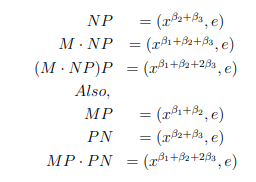
∴ (M · NP)P=MP · P N
ln the above computation (Q, ) = C2t × C 2 and the binary operation is defined as follows: (xβ1 , aα1 )(xβ2 , e) = (xβ1 +β2 , aα1 )
(b) M = (xβ1 , e); N = (xβ2 , e); P = (xβ3 , a) then
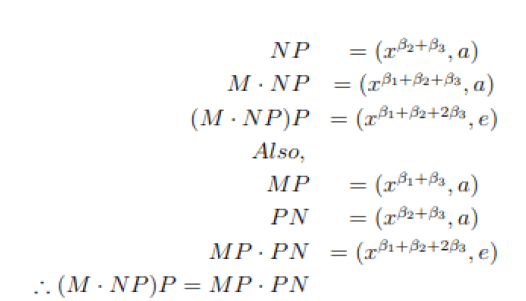
(c) M=(xβ1, e); N=(xβ2, a); P=(xβ3, e) then
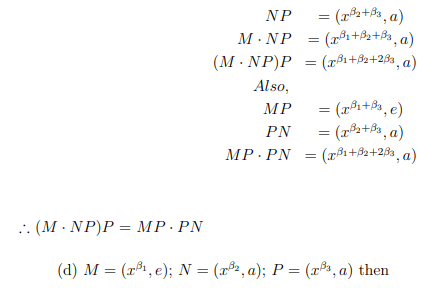
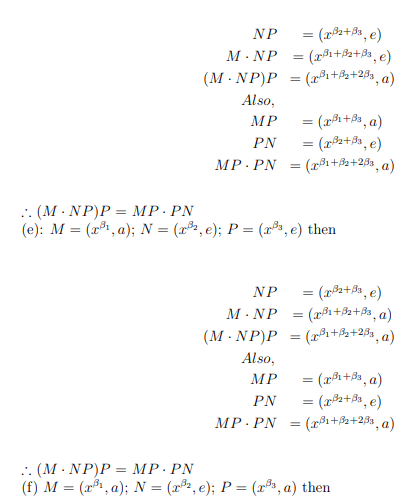
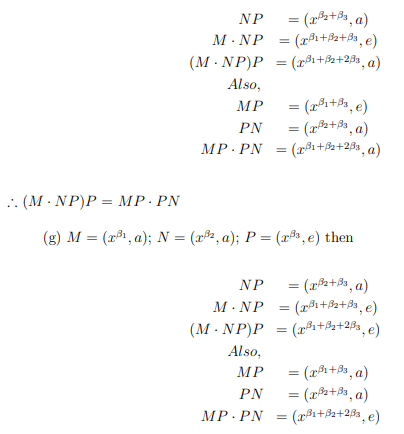
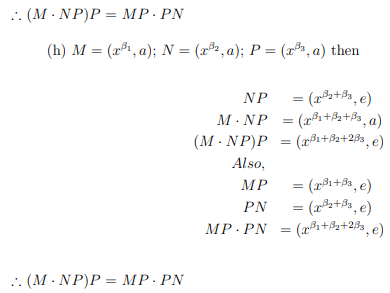
Also, (e, e) is the two sided identity.
If A=(xβ, e), then A−1=(x−β, e)
If A=(xβ, a), then
A−1=(x−β, a) if β=even
=(x−5β, a) if β=odd therefore, the inverses are defined.
Also, for non-associativity, let M=(xβ1, a); N=(xβ2, a); P= (xβ3, e) where β2 and β3
are odd integers, then
MN·P=(xβ1+5β2+5β3, a) and
M·NP=(xβ1+5β2+25β3, a)
MN·P=M·NP
thus the construction is non-associative except when t=2 which gives the group C4 х C2
hence, it is a right Cheban loop of order 4t, t=3, 4, 6.
Since (zyx)x=zx xy holds in cases whenever 251 (mod 2t), that is t=3, 4, 6 hence, the construction is a right cheban loops of order 4t where t=3, 4, 6 see solarin and sharma [23-25].
Construction (2): Let Q(◦)=C2t х C2 and the binary operation is defined as follows:
(xβ1, aα1 )(xβ2, a) = (xβ1+β2, aα1+1) if β2 ≡ 0 (mod 2)
=(x5β1+β2, aα1+1) if β2 ≡ 1 (mod 2) then
Q (o) is a Right Cheban loop of order 4t, where t=3, 4, 6.
Proof to show that the LHS and RHS of right cheban identity are satisfied, we proceed, by considering different possible situations, as follows
M=(xβ1, e); N=(xβ2, e); P=(xβ3, e) then by direct computations we have,
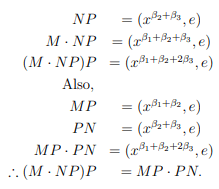
(b)M=(xβ1, e); N=(xβ2, e); P=(xβ3, a) then
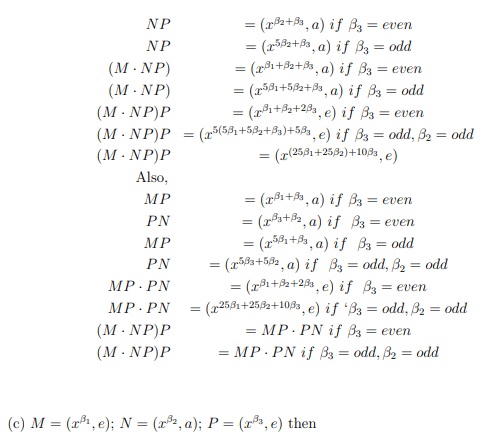
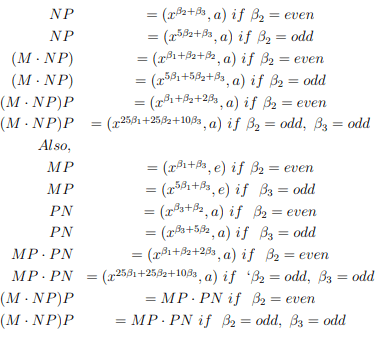
(d)M=(xβ1, e); N=(xβ2, a); P=(xβ3, a) then
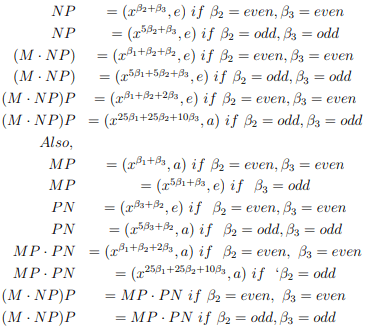
(e) M=(x β1, a); N=(x β2, e); P=(x β3, e) then
NP=(xβ2+β3, e)
M · NP=(xβ1+β2+β3, a)
(M · NP )P=(xβ1+β2+2β3, a)
Also,
MP =(x1β+β2, a)
PN=(xβ2+β3, e) MP ·
PN=(xβ1+β2+2β3, a)
(M · NP )P=MP · PN
(f) M=(xβ1, a); N=(xβ2, e); P=(xβ3, a)
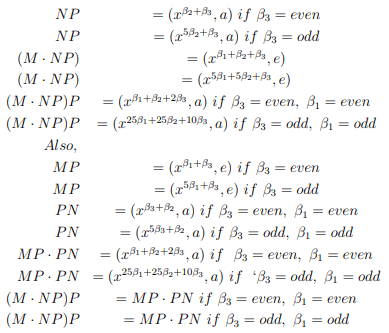
(g) M=(xβ1, a); N=(xβ2, a); P=(xβ3, e)
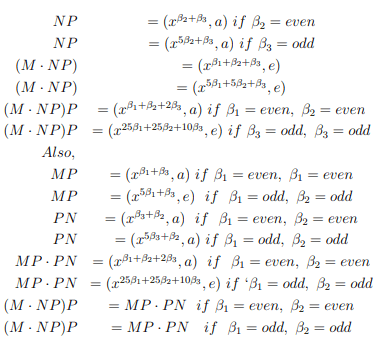
(h) M=(xβ1, a); N=(xβ2, a); P=(xβ3, a)
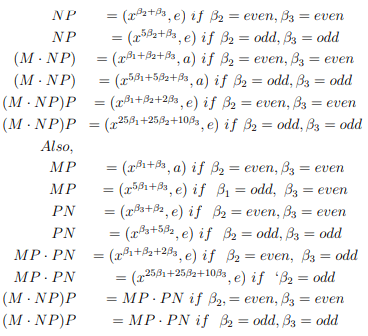
Also, (e, e) is the two sided identity. If A=(xβ, e), then A−1=(x−β, e) If A=(xβ, a), then
A−1=(x−β, a) if β=even
=(x−5β, a) if β=odd therefore, the inverses are defined.
Also, for non-associativity, let M = (xβ1, a); N = (xβ2, a); P = (xβ3, e) where β2 is an even integer and β3 is an odd integer, then
MN · P=(xβ1+5β2+5β3, a) and
M · NP=(xβ1+5β2+25β3, a)
MN · P ≠ M · NP
Thus the construction is non-associative except when t=2 which gives the group C4 х C 2 hence, it is a right cheban loop of order 4t, t=3, 4, 6.
Cayley of non-associative right cheban loops of orders 12, 16 and 24.
These are non-associative right cheban loops of order 12, 16 and 24. From the constructions, it was found that the smallest non associative right cheban loops is of order 12 and using Group Algorithm Programmings Software (GAPS), it was shown that right cheban loops are right inverse property loops, right conjugacy closed, power associative, right bol loops, right alternative and non-moufang loop, non-osborn loop, not diassociative loop and does not satisfy flexibility law and commutativity law.
[Crossref]